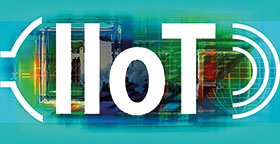

Smart factories are an important part of the Internet of Things (IoT). The term IoT describes the technologies that connect objects, from consumer electronics to industrial components, to the Internet. Meanwhile, the Industrial Internet of Things (or IIoT) refers specifically to the impact of this innovation on industrial applications.
IoT/IIoT technologies together create ‘smart’ networks. For example, the wireless technologies of a smart home connect homeowners to almost anything in the house, from their garage door to their refrigerator, and allow remote access via smartphone.
Similarly, a smart factory provides plant managers with remote access to wirelessly connected machines, as well as access to a wealth of data on the operation of those machines, by automating the communication between industrial automation equipment and systems. Data availability is one of the hallmarks of IIoT because it allows businesses to leverage data more meaningfully, including enabling predictive maintenance for machines.
Three key capabilities of smart factories are remote monitoring, predictive maintenance and process optimisation.
Remote monitoring
Visibility into the operational status of machine components (both historically and in real time) allows plant managers to monitor and diagnose systems quickly, as well as identify and resolve problems before the impact on machine availability and productivity compounds.
For example, tower lights with wireless communication allow remote operators to monitor machine performance without lengthy and expensive cable runs. The lights indicate machine status visually, while updates are also transmitted over a secure wireless network to a remote device, triggering an action or prompting a response from an operator at a work-station away from the machine.
The data logged by these devices can also be used in OEE (overall equipment effectiveness) calculations. Not only can operators respond to alerts quickly as they occur, but historical data can be used to track machine uptime, production volume, rejected parts and other key metrics.
Predictive maintenance
Predictive analytics allows for more accurate planning of machine maintenance, which can help reduce downtime, increase mean-time between failures (MTBF) and reduce costs of unnecessary preventative maintenance and spare parts inventory.
With predictive maintenance, much of the guesswork is removed because maintenance decisions can be made based on the historical and real-time data from the machine itself. For example, wireless vibration and temperature sensors like the QM42VT series from Banner can detect signs of misaligned, loose or worn parts on a machine. The wireless sensors then transmit that information to a wireless controller that makes data available immediately (via text or e-mail alerts) and for long term analysis.
By monitoring machine components in real-time for increases in vibration and temperature, problems can be detected and resolved before they become severe and cause additional damage or result in unplanned downtime. Over time, the historical data creates a valuable machine performance log that can be used to make more informed maintenance decisions down the line.
Process optimisation
The interconnectivity afforded by IIoT technologies enables seamless communication among machines, components, and people. For example, a wireless notification system can be used to alert managers and technicians that they are needed on the line, reducing the need for technicians and managers to check each production line or for workers to leave their workstations when they need assistance.
A system like this could be set up so that an operator pushes a button or flips a switch to alert the manager or technician that he or she is needed on the production line. A tower light connected to the gateway’s outputs would then indicate which production line needs a manager’s attention, and colours could be assigned to indicate the need for a technician (yellow) or manager (red).
Conclusion
Overall, the capabilities afforded by IIoT mean that these technologies are not just short-term investments or solutions to immediate problems, but rather, they enable continuous improvement by providing companies with the ability to solve new problems as they arise thus compounding the value of the investment over time.
For more information contact Brandon Topham, RET Automation, +27 (0)11 453 2468, [email protected], www.retautomation.com
| Tel: | +27 11 453 2468 |
| Email: | [email protected] |
| www: | www.turckbanner.co.za |
| Articles: | More information and articles about Turck Banner Southern Africa |

© Technews Publishing (Pty) Ltd | All Rights Reserved